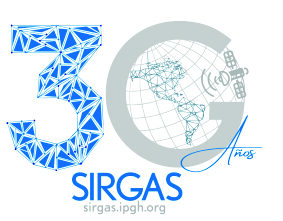SIRGAS is a non-profit organization set up for the Americas, driven by a voluntary agreement among the agencies of the Americas and the Caribbean responsible for the definition of the geodetic reference frames. SIRGAS supports cartographic production and research centers that perform activities linked to geodesy and geophysics. Its main objectives are the following:
a) Establish and maintain a continental geocentric reference frame (a network of stations with geocentric coordinates [X, Y, Z] of high precision and their variation over time [Vx, Vy, Vz]), in accordance with the recommendations of the International Association for Geodesy (IAG);
b) Define, put into effect, and maintain a unified vertical reference system by means of physical and geometric heights that are consistent at the global level, in accordance with the recommendations of the IAG;
c) Develop and update a gravimetric geoid model for continental coverage, in accordance with the recommendations of the IAG; and
d) Establish and maintain a continental absolute gravity network, in accordance with the recommendations of the IAG.
Geocentric reference system
SIRGAS as geodentric reference system is defined identical to the International Terrestrial Reference System (ITRS). Its realization is a regional densification of the global International Terrestrial Reference Frame (ITRF) in the Americas and the Caribbean. The reference station positions are associated to a specific (reference) epoch and their variation with time is taken into account by discrete station velocities or by a continuous velocity model, which comprises tectonic plate movements and crustal deformations. Realizations or densifications of SIRGAS associated to different reference epochs and referring to different ITRF solutions materialize the same reference system and, after reducing their coordinates to the same frame (ITRF) and reference epoch, they are compatible at the mm-level. The extension of the SIRGAS frame is carried out by national densifications of the continental network, which serve as local reference frames.
The geographical coordinates are derived by applying the parameters of the GRS80 ellipsoid.
The activities related to realization and maintenance for the geocentric reference system are coordinated by the SIRGAS-WGI: Reference System. The activities related to the densification and application of SIRGAS at national level are coordinated by the SIRGAS-WGII: SIRGAS at National Level.
Vertical reference system
The vertical datums presently used in the Americas and the Caribbean refer to different sea levels and different epochs, they do not take care of the height and reference level variations with time, and in most of the countries, the vertical networks were processed without including the corresponding gravity reductions in the levelled heights. These datums present big discrepancies between neighbouring countries, they do not permit data exchange neither in continental nor in global scale, and they are not able to support practical height determination with GNSS techniques.
In contrast, the new SIRGAS vertical reference system shall:
- refer to a unified global reference level W0,
- be realized by proper physical heights (derived from spirit levelling in combination with gravity reductions or from gravity field modelling of high-resolution),
- be connected to the SIRGAS geocentric reference frame, and
- be associated to a specific reference epoch, i.e. it should consider the coordinate and referential changes with time.
The official recommendation of SIRGAS about the physical heights is to introduce normal heights; however, since some countries want to adopt orthometric heights, it was decided to define the new vertical reference system in terms of geopotential quantities (W0 as a reference level and geopotential numbers as primary coordinates), and then, in the realization, each country can introduce the desired physical heights with their respective reference surface: the geoid or the quasigeoid.
The definition of the new SIRGAS vertical reference system is identical with the definition of the International Height Reference System (IHRS) given by the resolution No. 1, 2015, of the International Association of Geodesy (IAG). The realization of the new SIRGAS vertical reference system must be a regional densification of the International Height Reference Frame (IHRF).
The activities related to the definition and realization of the new vertical reference system for SIRGAS are coordinated by the SIRGAS-WGIII: Vertical Datum.
